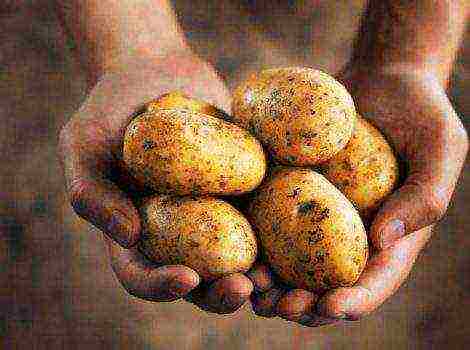Content [show]
For a small plot of land, bundled cucumbers can be called a godsend, they take up little space.Hybrids are genetically capable of forming from three to nine ovaries from each node. Thanks to this, the yield increases several times. Every year, bunch cucumbers for open ground are gaining more and more popularity. We will talk about how to grow this type of cucumber in this review.
Description of bunch cucumbers
Bunch cucumbers belong to the pumpkin family. It is an annual plant with a stem up to 2 m long. The type of fruiting, called bunch or bouquet, resembles bunches of mini-bananas. Fruits are small - gherkins or pickles. Pollination type hybrids can be parthenocarpic and bee-pollinated. Almost do not form barren flowers. Very light-requiring.
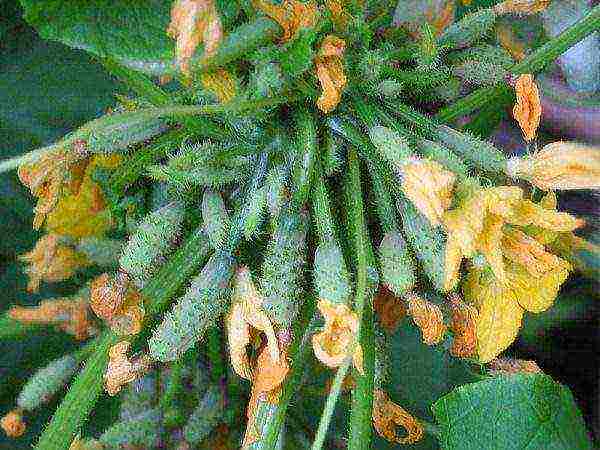 Ovary of bunch cucumbers
Ovary of bunch cucumbers
They are divided according to the type of branching into:
- Strong... The most productive, but laborious to care for. Has a long growing season;
- Average... The yield is slightly lower due to the shorter fruiting period;
- Weak... Almost do not form lateral processes, do not need pinching. The growing season is short, the yield is slightly lower than that of the previous types. Doesn't require painstaking care.
The best varieties for open ground
Seeds of bunch cucumbers are more expensive than seeds of classical types. But, 5 seeds of a standard package will make 5 bushes, which will provide a harvest of fruits of about 45-50 kg during the growing season.
According to reviews, the following varieties are popular with gardeners:
Prestige F1
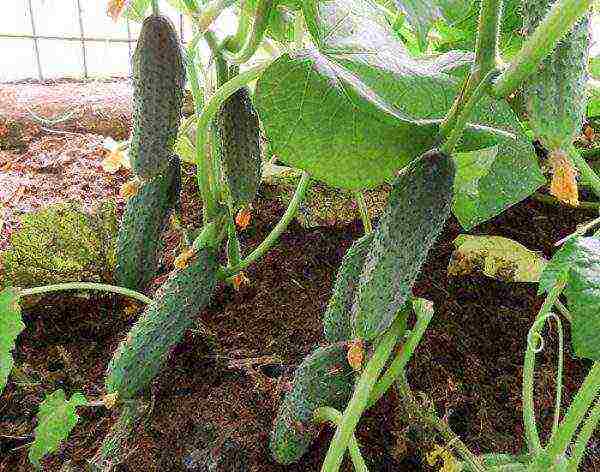 Cucumbers Prestige F1
Cucumbers Prestige F1
Domestic variety selected by the Sedek company. Medium early, with the onset of fruiting in 43-45 days. Medium branching type, parthenocarpic, self-pollinated. Included in the State Register of Plants of the Russian Federation in 2007. Created for central Russia.
There are 3-4 ovaries in the node. Productivity 25 kg per 1 m2. Fruits are green with whitish stripes, large tuberous with thorns. The taste is juicy, the pulp is not bitter, almost without seeds.
Long fruiting until frost. Purpose salad, suitable for preparations.
Beam splendor F1
 Cucumbers Bundle splendor F1
Cucumbers Bundle splendor F1
Bred in the Urals. Early maturing, parthenocarpic. Medium - branched. Its advantage is its tolerance to temperature changes, many diseases, pests. Suitable for the northern climate of the Russian Federation. One knot contains 3 to 7 ovaries. Prolonged fruiting until frost. The yield is high, one bush gives up to 400 fruits with proper care.
Planting scheme - 2 bushes per 1 m2. It is better to form a plant into one stem, then the tying of cucumber bouquets occurs on the main whip. It will not waste energy on the growth of lateral processes.
Zelentsy are cylindrical, medium - lumpy. The color is light green with whitish stripes and thorns. The variety is universal for consumption.
Ginga F1
 Cucumbers Ginga F1
Cucumbers Ginga F1
Bred in Germany. Mid-season, self-pollinating. Vegetation lasts 45-50 days. Bushes are medium - branched. Zelentsy are medium in size, 10-11 cm, bright green, with whitish stripes, small tubercles. Taste without any signs of bitterness. Fruits without voids. Productivity is 4-6 kg per 1 m2. Resists well cucumber mosaic, powdery mildew.
Alligator F1
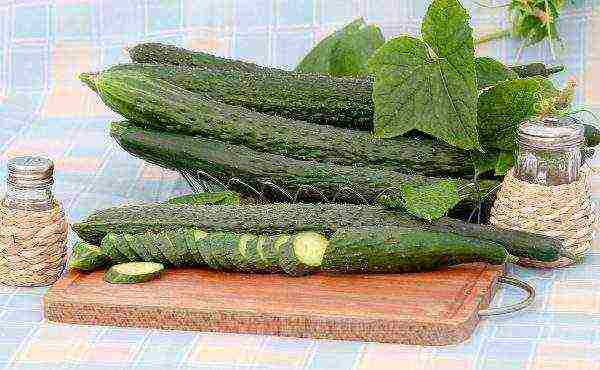 Cucumbers Alligator F1
Cucumbers Alligator F1
An interesting variety in appearance. Medium early, from germination to maturation 45-53 days. Bee-pollinated. The bushes are highly branched, with 1-3 ovaries in the axils. Fruits are dark green, up to 40 cm long, prickly pimples. Fruit weight up to 300 g. Productivity 15 kg per m2. The pulp is very tender, without bitterness. Salad cucumbers. The benefits include disease and rot resistance.
Okhotny Ryad F1
 Cucumbers Okhotny Ryad F1
Cucumbers Okhotny Ryad F1
Parthenocarpic hybrid. Early maturing, the period before the appearance of ovaries is 40 days. Medium - branched bush with 6 ovaries in the leaf axils. Long-term fruiting. Seedling growing is recommended. Zelentsy cylindrical with thorns. The taste is pleasant. A variety of universal use.
A disadvantage can be considered that the plant is not entirely resistant to penosporosis - downy mildew, therefore, preventive measures are necessary.
In addition, there are such common varieties of bouquet cucumbers, as Blizzard F1, Yamal F1, Champion F1, Zyatek F1, Boy with a finger F1, Bouquet F1, Masha F1, Captain F1. It should be noted the new early-ripening variety Siberian garland F1, resistant to low temperatures, tolerates partial shade.
Breeding work on varieties of bunch hybrids does not stand still. More recently, a variety of gherkins with a growth retardation was bred, that is, the fruits do not outgrow, up to 12 ovaries are formed in one bunch.
All varieties grow well in open beds, without greenhouses.
The variety of cucumbers must be selected according to the specific growing conditions, taking into account the species characteristics and ripening periods. It is necessary to take into account the type of branching, the degree of resistance to diseases.
Features and rules of cultivation: cucumber ovary and fruiting
The process of growing bunch cucumbers in the open field is similar to growing conventional varieties, but there are some nuances.
 Harvest of bunch cucumbers
Harvest of bunch cucumbers
If the plant is weak and is not able to provide a large number of ovaries with nutrients, then they begin to dry out and fall off. To avoid such a situation, we follow the following rules:
- One week before landing we add 10-15 kg of compost to the finished bed and 30-40 g of complex mineral fertilizer per 1 m2. Digging up.
- The day before planting seedlings we spill the garden well. We plant at a soil temperature of +10 degrees at a depth of 10 cm.
- We disinfect each well liter of warm pink potassium permanganate solution.
- We plant seedlings in a row every 40-50 cm, since all bunch cucumbers do not like crowding. We mulch with humus.
- Installing the trellisbetter with mesh. We form a bush in a timely manner and pinch the side branches for the appearance of ovaries.
In the open field, the fruiting of bunch cucumbers is much higher if grown on a trellis.
- We shape it in a special way. We remove all flowers and processes in the axils of the lower 4 leaves. You do not need to touch 2 lateral shoots with ovaries, pinching them. We pursue the task - to achieve the maximum harvest from the main stem.
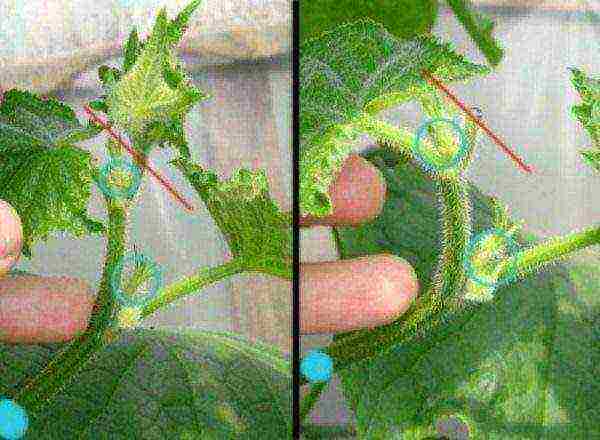 Grassing ovaries of bunch cucumbers
Grassing ovaries of bunch cucumbers
- Pour warm water, preventing the soil from drying out. After watering, we do shallow loosening.
- The root system of bouquet cucumbers does not like a high concentration of salts, we apply complex fertilizers in small doses, but more often - once a week, 15 g per 1 m2. Organic dressings are shown 2 times a month with a solution of poultry droppings or manure.
- Periodically we carry out foliar dressing for better flowering and fruit formation.
- We collect cucumbers often, a maximum of every other day. We cut out the fruitful lashes, we carry out foliar spraying with urea, fruits grow on new shoots.
The number of ovaries depends on the growing conditions. Illiterate agrotechnical care gives less result.
Factors negatively affecting the ovary:
- excess nitrogen;
- irregular watering;
- flaw solar lighting or its excess.
Main advantages and disadvantages
Bunch cucumbers have many undeniable advantages:
- Stable, high yield without the formation of "overgrowths". On average, the yield is 10 kg per bush.
- Mass maturity.
- Compact dimensions for canning.
- Stable immunity to diseases.
- Tolerance to temperature drops.
- Early maturity... The appearance of the first cucumbers after 38-40 days, even after 35 - depending on climatic conditions.
- Ideal taste qualities and versatility of use, well kept.
 Bundle arrangement of cucumber ovaries
Bundle arrangement of cucumber ovaries
Conditional disadvantages include the need for frequent fruit collection for the full maturation of new ones. This inconvenience will affect mainly summer residents who are not able to visit the site every day. They need to pay attention to varieties that are less demanding to care for.
Conclusion
Bunch cucumbers for open ground are modern hybrids that have absorbed the best qualities of this vegetable crop. They are unpretentious in care, but their cultivation presupposes the observance of agricultural techniques. The variety of varieties on the seed market will allow you to choose the varieties that are right for you.
Breeders never cease to amaze gardeners with new achievements. A striking example is the appearance of bundle varieties of cucumbers, bearing fruit in bouquets of strong greens. Disease resistance, abundant fruiting, a wide selection of varieties, unpretentious care - this is an incomplete list of the advantages of this type of green vegetables.
Bunch cucumbers - origin and characteristics
Bundle varieties of cucumbers were named because of the peculiarity of the formation of ovaries in the nodes of the stems. Unlike the usual varieties, which form 1-2 inflorescences, this type of zelents is capable of producing from three to ten ovaries, luxuriantly growing from one node, which gave the second name of these vegetables - bouquet.
The yield of bunch varieties is amazing - with proper care, each plant is capable of producing a harvest of 400-500 fruits per season.
Ovaries in bouquet varieties form bunches of greens in the nodes of the stems
It is clear that such a miracle became possible thanks to the work of breeders, bunch varieties are first generation hybrids. Such hybrids are not suitable for harvesting seeds. Even if it is possible to collect future planting material, there will be no seedlings, or something will appear radically different from what was expected.
Among the representatives of this species are parthenocarpic varieties (F1 Blizzard, Boy with a finger, Robin Hood, Okhotny Ryad), and pollinated ones (F1 King of the Garden, Anyuta, Emerald City, Maryina Roshcha). The choice of the variety depends on where it is planned to grow the crop - in the open field, pollination by bees is possible, in the greenhouse, parthenocarpics are preferable.
One of the defining differences in this type of cucumber is the type of branching:
- Weak branching - lashes form few short lateral shoots, do not require pinching. Early ripening, fruiting up to one and a half months, bring a high yield. These include varieties F1 Alphabet, Bouquet, Balalaika. Representatives of such varieties are good for early harvests.
- Limited branching gives a longer fruiting time, few lateral processes. Leaving is not difficult, pinching takes a little time. The cultivars are mainly grown in the greenhouse. Examples: F1 Grasshopper, Cheetah, Trump card.
- Strong branching in varieties that bring greens for a long time, suitable for greenhouse conditions and in the open field. Representatives of this species: F1 Marina grove, Buyan, Boy with a finger, Junior lieutenant, Chistye prudy.
Popular varieties
There are many varieties of bouquet cucumbers, the choice depends on the preferences of the gardener and the conditions in which the cultivation is planned. Breeders have bred many different types of bouquet greens, with different types of branching, early maturity, and duration of fruiting.
Bunch cucumbers for open ground
In principle, many varieties of bunch cucumbers are suitable for cultivation in open ground. The choice is limited by the climatic conditions of the area in which it is planned to plant them. In the middle lane, open ground cucumbers are planted under film shelters or tunnels, in the southern regions they do without shelters.
You can choose a variety depending on what is preferred: early harvest or long ripening of cucumbers. Consider varieties popular with gardeners.
- F1 Green wave - refers to parthenocarpic, pleases with an abundance of fruits. It stands out for its early maturity - you can eat fresh greens in 38-40 days after germination. This option can be grown without shelter, the variety tolerates a drop in temperature, the stem is distinguished by good branching. This representative of bouquet varieties has neat cucumbers, 9–11 cm in length.
- F1 Mother-in-law is a hybrid of the parthenocarpic category. A fresh harvest pleases the owner 45–48 days after germination. Bunches of ovaries (3-4 per knot) bring medium-sized cucumbers, 11-13 cm long.
- F1 Zyatek is a pollinated variety forming 6-8 ovaries (female). After 45 days from the day of germination of seedlings, medium-sized (10-12 cm) greens are ready for consumption. Favorably distinguishing nuance - fruiting does not stop with the deterioration of external conditions.
- F1 Little son is a strong branching variety, parthenocarpic. In the axils of this medium-sized cucumber 3-4 ovaries are formed, according to the type of flowering - female. Little son is a representative of early ripening varieties, greens of 6-10 cm in size ripen in 45 days from the emergence of shoots.
- F1 Heroic strength - parthenocarpic. Gives early (37–40 days from germination) results, long fruiting, moderate branching of the stem. Juicy greens ripen from 6-8 ovaries, the length of which does not exceed 13 cm.
The efforts of the breeders have instilled resistance to the main diseases in the bundle varieties of cucumbers. Even in affected plants, the ability to bear fruit (disease tolerance) does not decrease.
Varieties of bunch cucumbers for growing in shelters
All varieties for open ground are suitable for growing in greenhouses, this is especially true for regions with unstable climatic conditions. But preferable are types of bunch cucumbers with moderate or weak branching type and parthenocarpic type of ovary formation. This is due to considerations of practicality and ease of maintenance.
To optimize the growing conditions, a strong thickening of the plantings should be avoided, this leads to a lack of lighting, which adversely affects the development of plants. With the choice of parthenocarpic varieties, there is no need to worry about pollination of the ovaries.
Indoors, cucumbers are provided with the most favorable conditions
Among the bouquet varieties suitable for growing indoors, consider the following:
- F1 Blizzard is a weakly branching parthenocarpic. The emerged plants give a harvest in 37 days. In each node of 4-5 ovaries, bundles of gherkins develop, the length of which is no more than 8 cm.
- F1 Balcony - as the name implies, the variety is bred suitable for cultivation in small areas - loggias, balconies. Will feel comfortable in greenhouses and temporary shelters. The internodes of this parthenocarpic are short; the stem branches weakly. In 41 days after germination of seedlings, green plants ripen 6-10 cm long, from two to eight in each node.
- F1 Swallowtail is a precocious parthenocarpic, well suited for greenhouses and balconies. The distance between the nodes is small, the shoots grow small (determinant).In the nodes, from 2 to 11 ovaries are formed, which, 40 days after the appearance of the first shoots, give crisp, dense greens 7–11 cm long.
- F1 Labyrinth - fresh cucumbers of this parthenocarpic appear quite early - 38–40 days after germination. Small fruits, about 12 cm in size, are formed in 4–5 pieces per bunch. The stem has medium branching, few shoots.
- F1 Urban Gherkin - This gherkin is harvested early in 40 days from germination. The cucumbers are thin - 2.1–2.7 cm in diameter and 9–12 cm long. The undoubted plus of this species is shade tolerance, the plant grows well on shaded balconies, it is also cultivated on the windowsill in the apartment. Ideal for greenhouses. The knots form three to nine ovaries.
- F1 A boy with a finger - in the nodes of this parthenocarpic, from two to eight gherkin type zelents 8–10 cm long are formed. Due to the early maturity, they ripen within 36–38 days after the germination of crops.
- F1 Junior lieutenant - interesting for a special property that distinguishes him from the background of the beam counterparts - self-regulation of branching. Ovaries are formed on the main stem, while such a load does not allow lateral shoots to develop. After harvesting from the main stem, lateral shoots also start growing, on which cucumbers also ripen. Between the germination of crops and the ripening of zelents, 40–42 days pass. The number of ovaries in bunches is from 2-3 to 5-7, the cucumbers are juicy, 9-12 cm long.
Cucumbers with slow fruit growth
For those gardeners who come to the plots only on weekends, specially bred varieties with slow growth of zelents are suitable. Breeders have bred a number of varieties that form many inflorescences, when ripe, the growth of the cucumber slows down when it reaches a certain size. This is convenient when it is impossible to harvest the crop regularly every other day.
- F1 Acorn is a bee-pollinated hybrid, a representative of the cucumber type with slow fruit growth. Weakly branching, gherkin type, forms bouquets of 10-12 ovaries in knots. Calmly tolerates the infrequent collection of fruits that stop growth when they reach a length of 8–10 cm. Delicious, juicy greens can be removed after 45–47 days from germination.
- F1 Captain - good yields, bee-pollinated. The branching of this variety is limited, the growth of zelents is slowed down. In the knots, bunches of 2 to 10 pieces are tied, 40–43 days after germination of the seedlings, fruits 8–10 cm in size are ready for harvesting.
- F1 Stay healthy - unlike previous parthenocarpics. It does not cause trouble with leaving due to weak branching and slow growth of fruits. The first cucumbers ripen 40–43 days after the germination of seedlings. Each node contains from two to six ovaries. 6-9 cm gherkins are good both pickled and salted.
Video: new varieties of bunch cucumbers
Features of growing bunch cucumbers
Bundle varieties of cucumbers actively bear fruit, forming a large number of ovaries. For their full development and growth, it is important to remember that such a load on the plant requires careful care and makes additional demands on the conditions of detention.
- Plants are demanding for light. It is necessary to arrange bunch cucumbers in well-lit areas, without shading. Insufficient illumination will adversely affect the formation of ovaries.
- Weekly feeding is especially important during the period of growth and ripening of fruits. Nutrients are consumed for the growth of numerous fruits, their lack will lead to a decrease in yield. Cucumbers are fed with small doses of complex mineral fertilizers, using, for example, Crystalon, a solution in the volume of one tablespoon per bucket of water.
- Regular collection of fruits is required for the ripening of subsequent ovaries, usually the collection is carried out every other day. Bouquet cucumbers are grown on a trellis
Formation of bunch cucumbers
Bouquet varieties are rarely planted - one or two plants per square meter.
The formation of bunch cucumbers is carried out in one stem, otherwise the plant's strength will be spent on lateral shoots, which leads to a decrease in fruiting. The four lower nodes of the main stem are "blinded" - flower stalks break off, shoots are removed. Thus, ovaries remain on the stem in each node with one leaf.
Bunch varieties are formed into one stem
Video: forming a cucumber into one stem
What gardeners say
Cucumbers of bundled varieties make it possible to collect bountiful harvests while saving space, and the taste of the fruit will appeal to lovers of juicy vegetables. Perhaps caring for them is burdensome, but choosing the right variety and putting a little more effort, the harvest of strong, crispy gherkins will certainly delight its owner.
Below are other entries on the topic "Cottage and garden - do it yourself"
Crop rotation on a shaded bed: Crop rotation for shade - table We ... When to plant plants and seedlings in open ground: Table: When to transplant seedlings in an open field ... Preparation of soil for spring planting of seedlings - a reminder to the summer resident: We prepare soil for seedlings in the fall ... Key indicators of growing seedlings: Memo for growing seedlings - ... Key indicators of sowing and planting seedlings: Sowing and planting seedlings - ... Memo on the use of drugs to combat pests and diseases: Table of drugs to combat ... Transplanting lilies - we put them in order after a difficult summer: Lilies: " reboot ": transplantation and reproduction The current ...
Subscribe to updates in our groups.
Let's be friends!
